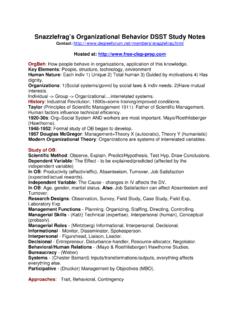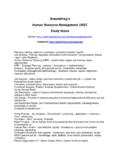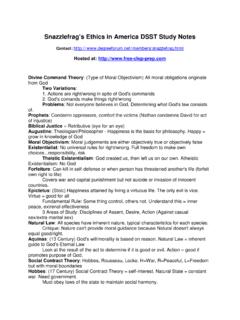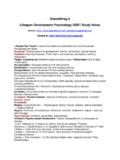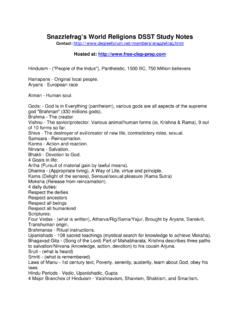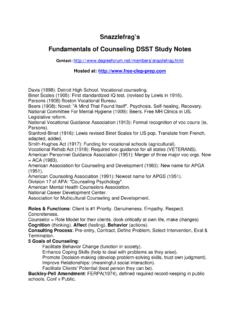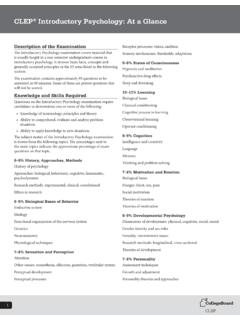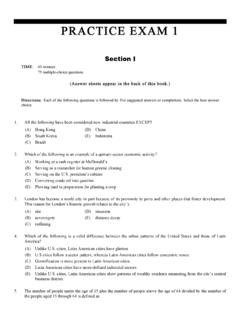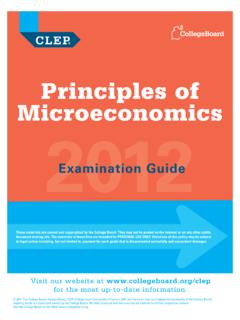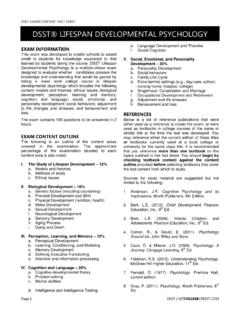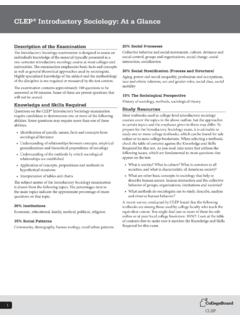Transcription of Intro to Psychology Study Notes - Free Clep Prep.com
1 Snazzlefrag s Intro to Psychology Study NotesContact: at: Figures:Bandura: Social-Cognitive. Social Learning. Observational learning, imitation : Intelligence : Interactive Dualism. Mind/Body interact but processes are : FunctionalismFreud: Psychoanalysis. Eros/Thanatos. ID (pleasure), Ego (reality), Superego (idealistic-Conscience/Morals).Oral(0-18 m), Anal(18m-3), Phallic(3-6), Latency(6-pub), Genital(puberty+)Horney: 10 Neurotic Needs (causes of Anxiety, Depression).Harlow: Set (set way to solve problems).James: Functionalism, Harvard, Classroom Study . Philosopher not 's Morality: Preconventional(Punish,Reward) Conventional(good,authority)Postconventi onal(Contract,Morals)Locke: British Empiricism.
2 Blank : Cognitive Development (accomodation of schemas).Rogers: Humanism. Reaction to behaviorism. Put "person" back into Psychology . I/MESkinner: Behaviorism. Psychology = Study of Observable BehaviorTitchener: Structuralism/Introspection. First Lab (USA)Watson. Behaviorism. Phys reaction to env stumili. Study of mentalprocess=unscientific. "Father"Wertheimer: Gestalt. Whole is greater than the parts. Totality (not indiv components).Wundt: Structuralism/Introspection. Scientific Method. First Lab (Germany),experimental Psychology :Behaviorist: Learned responses to stimuli. Study , Skinner, PavlovBiological: Genes, Nervous System, Hormones, : (react to Behav) thinking, problem-solving, memory, language, ,BanduraFunctionalist: What is the purpose/function of our mental , JamesHumanistic: People = Basically good.
3 Self-actualization. Unique ,MaslowPsychoanalytic: Innate drives, society's restriction on , Jung, Adler, Horney, EriksonStructuralist: Introspection, what ingredients make up our mental : Individual Nerve > Soma > Axon(Myelin) > Axon Terminal (Neurotransmitters) > Synapse(cleft)Axon: SENDS messages to nearby neurons, glands, or : RECEIVE messages from nearby toward cell body(soma)Glial Cells: Create Myelin, support, guide, (association): Carry impulses WITHIN the brain or spinal cord. Neuronto Neurons(efferent): Carry impulses AWAY from brain or spinal cord towardmuscles and Neurons(afferent): Take in info and carryimpulses TOWARDS brain orspinal Refractory Period: Resting pause, neurons pump positively chargedsodium back :Parts of the brain-Stem>Thalamus/Hypothalamus>Reticul arFormation>Cerebellum>Cerebral Cortex>Corpus (in Limbic System): Emotion (fear/aggression), Evaluation of Ganglia: Muscle contractions, movementsBrain Stem: (separates brain and spinal cord) Medulla & Nuclei (basic life reflexes).
4 Broca's Area: Brain. Controls muscles involved in Nervous System: All neurons/nerve fibers surrounding brain and spinal Cortex: Outer Covering, Receives sensory info and transmits motor (sound),Frontal(spch/lrning/thnk/decis/a bstract),Parietal(sensory/attention),Occ ipital(vision).Cerebellum: Voluntary fine motor System: (hormones). Network of glands that affect (brain,master), Thyroid(neck,metabolism),Adrenal(kidneys ,emotions/stress/threat)Hippocampus(in Limbic System): Long-term and Spatial (in Limbic System): Controls motivated behavior (hunger, thirst, sex,temperature regulation)Limbic System: Lower brain. Motivational/emotional stress. Response to threat :Breathing, Waking, Heartbeat, Swallowing, Nervous System: Two Nervous System: Voluntary Muscles, Sensory organs (eyes, ears, skin,etc.)
5 Autonomic Nervous System: Involuntary actions, internal organs (excites), Parasympathetic (relaxes).Pituitary Gland(in Limbic System): Master Gland, controls hormones from otherglandsPons: Facial expressions, sleep, Formation(in brain stem): Arousal level (Eg, alert or asleep). NOTfear/aggression (amygdala)Thalamus: Relays sensory info to 's Area: Brain. Sounds are decoded and & Perception: PsychophysicsAbsolute Threshold: Minimum amount to detect 50% of Threshold: Just Noticable Difference (JND) between two 's Law: Harder to notice differences if more intense stimuli (louder, brighteretc.) Proportion/%Grouping: Closure, Similarity, Proximity, ContinuityVisual Cliff: 6 : Protective covering where reflected light first enters the Vision: Two Theories (Trichromatic Theory, Opponent-process Theory)Trichromatic Theory(Young-Helmholtz): 3 cones=3 wavelengths (RGB).
6 Notexplain neg (Hering): Paired Receptor Cells (RG, BY, BW).Stimulate 1 = Inhibit : Colored part. Contains the : Bends (refracts) light. Focuses a flipped, inverted image onto Waves: Electromagnetic waves, stimulate receptors in the : Amount of Energy per unit of time (brightness)Wavelength: Distance between two crests (color)Optic Nerve: Carries visual info to lateral geniculate nucleus of the Spot: Where optic nerve exits the eye. No receptorcells = no : Thin structure, back of eye. 2 types of receptor cells:Rods: Periphery of retina, black and white. Best in low light, : Middle of retina (fovea), color/details. Best in daytime, more visual Ear(pinna): Collects sound from air and directs it through the ear Membrane(eardrum): Vibrates when sound hits Window: Membrane separates middle ear from inner ear.
7 Sends vibrations : Fluid-filled membrane in inner ear. Pressure changes stimulate hair Waves: Vibrations (change in air pressure) that stimulates auditory : Height of Wave (loudness).Frequency: Length of Wave (repetitions,pitch)Place Theory: Hair cells respond to frequency based on location in Theory: Hair cells fire at different frequencies in the cochlea, so wesense (olfaction): Chemical. Inhaled molecules excite receptors in the (gustation): Chemical. Taste buds on tongue. Salty, Sour, Bitter, Sense(somesthesis/touch): Mechanical. Pressure, Pain, Warmth, Sense: Mechanical. Innerear. Orientation, Balance, Location of head Sense: Receptors in muscles, tendons, joints, relay information about : Being Aware.
8 Awake/Sleep Circadian : Rises early in morning, peaks around midday, dips mid-afternoon, dropslate : 5 Stages (90 minute cycle):Awake:AlphaWaves but relaxed (slow, regular)Stage 1 (5 mins):ThetaWaves. Slower breathing, irregular brain waves.'hypnogogic' (falling).Stage 2 (20 mins): Deeper relaxation, occasional burst of brain activity (SleepSpindles)Stage 3:DeltaWaves (Slow-wave Sleep-hard to awaken). Large, slow into Stage 4 (30 mins): Stronger, consistent Delta Waves (Slow-wave Sleep-hard toawaken)Then (after 1 hour).. Stage REMREM(10 mins): 1950s Kleitman & Aserinsky. "Paradoxical Sleep", like when awake, Spindles: Brief, high amplitude bursts of electrical energy.
9 Person is asleep buteasily :Freud: Manifest Content=Actual Images, Latent Content=Real meaning (sexual,aggressive).Activation-synthesis Theory: Neurons Random fire, dreams attempt to makesense of : Consolidate day's events and stamp into :Associative Learning: Learning a connection between two stimuli (CC), or a stimuliand a response (OC)Cattell: Crystalized Knowledge, Fluid Learning: Repeated presentation of a single : Getting used to repeated noises, or hum of lights : Repeated/Intense presentation = respond to even weaker : "Problem-solving Activities"-Thinking, Language, Memory, Bias: Look for info toback up your Fixedness: Can't see new uses for familiar objects.
10 (Eg, quarter works as ascrewdriver).Heuristics: Mental rules of thumb/Shortcuts. Estimates, likelihood. "Representativeness& Availability".Language:Babbling Stage: (4-6month to 1yr). Practice sounds. No longer recognize foreignlanguage soundsOne-word Stage: (1yr to 18months). Word PLUS gestures =Telegraphic Speech(also in Two-word Stage)Two-word Stage: (18+ months). Noun + Verb ( ), later Adjective +Noun(Bad Doggie).Language Acquisition Device(Noam Chomsky): Universal built-in mental systemhelps us learn : Words or parts of words that convey : Rules for mapping morphemes onto the ideas they :Rules for combining morphemes in meaningful : Sensory > Short-term > Long-term (ie, Procedural, Semantic.)
